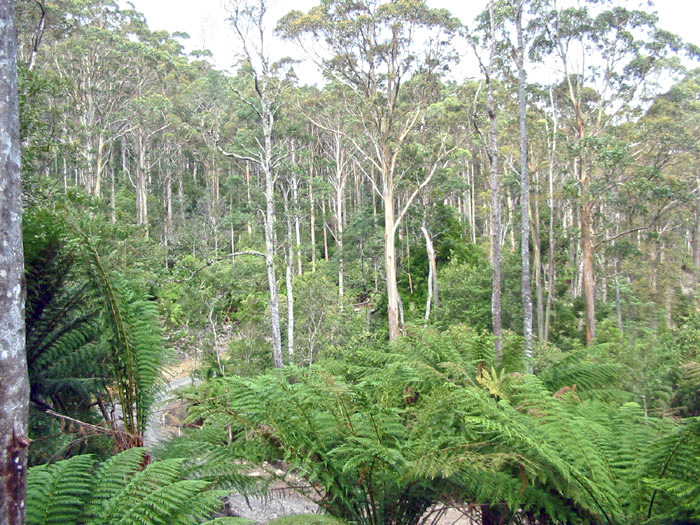The prospect offered by the Wilderness Society of getting a return on standing trees deserves serious consideration by government and industry.

Forest near Blue Tier in NE Tasmania, part of the area dubbed “future potential production forest” (FPPF), which could benefit from carbon credits. PHOTO Otway Ranges Environmental Group.
We’re failing the ultimate test of success in cutting carbon emissions: the amount of carbon dioxide in the air. Tasmanian carbon dioxide levels are now above 400 parts per million and rising.
That’s one reason the Hodgman government should take a good hard look at a new proposal from the Wilderness Society. Another is the continued depressed state of forest industries.
Trees have many assets, but their most valuable one right now is helping to stop the planet’s greenhouse gas budget getting completely out of hand by taking up carbon dioxide from the air. The more growing trees we have in the ground, the better.
Doubt about human-induced climate change, deeply-embedded in conservative politics across the country, has severely limited the scope of Coalition abatement policy and prevented any effective move on smokestack or tailpipe emissions.
Hence the federal government’s uncharacteristic interest in trees. Environment minister Greg Hunt has made them his key strategic tool, reflected in the fact that well over half of abatement funding from the Emissions Reduction Fund (ERF) so far has gone to planting and tending trees.
In 2012, a study commissioned by Tasmania’s Labor-Green government used state-of-the-art methodology to determine that the carbon sequestered by our island’s forests could deliver as much as $352 million to the state under then-current carbon prices.
Back then there was hope that the Tasmanian Forest Agreement could lead to at least some of this abatement value being realised, but this never happened before the agreement was abandoned by the present Liberal government in 2014.
But a new report by the author of the original 2012 study offers a persuasive argument that it remains very much a live option for Tasmania to pursue ERF funding for its massive forest resource – so long as suitable assessment methodologies can be developed.
Last year the Wilderness Society commissioned Barrie May of TreeMod, a Melbourne environmental consultancy, to investigate how Tasmania could get a cash return, and what this might be, if it kept various forest areas intact.
The TreeMod study looked at the abatement potential of not harvesting the area flagged as “future potential production forest” (FPPF), while allowing for current harvesting plans to be realised. It estimates that by 2050 this could realise at least $68 million and probably much more.
These lands are under a harvesting moratorium till 2020, but the Hodgman government opened up the option of harvesting after then. This assumes that harvesting would add value to the lands, an assumption that looks shakier as each passing year ramps up the pressure to lower net emissions.
TreeMod spells out how we can secure long-term, reliable income from the 357,000 hectares of FPPF land. But for that to happen, forestry interests and governments in both Canberra and Hobart need to be on board.
That task looks impossible when you consider the mutual mistrust bedevilling the industry. Environmentalists fear the loss of natural values, timber harvesters fear income loss from land reservation, and farmers fear plantations swallowing their farms.
The standoff between key players has resulted in native forests and most plantations being ruled inadmissible for ERF support, despite their great potential to contribute to carbon abatement. That unfortunate exclusion can’t have been lost on Hunt.
Facing difficult times, many in the industry would surely be tempted by the security of diversified revenue streams: credit for sequestered forest carbon as well as income from harvesting. The TreeMod report offers a methodology that allows land owners and managers, including state governments, to maintain a harvesting industry while also getting carbon credits from varying harvesting rates, excluding areas from harvest and planting trees on existing cleared land.
Barrie May’s reports show how we can measure the complexities of carbon abatement resulting from these activities, and the Wilderness Society aims to use that to engage with government and other forestry players to find a viable future for our forests.
This cries out for a positive response.
